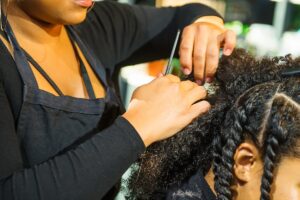Hair growth moments from TikTok influencers promoting hair growth remedies like hair oiling/slugging, a rosemary and caffeine mixture to promote hair growth, and hair cycling similar to skin cycling are on the radar of those who want to achieve the ultimate hair goal— healthy long hair. But does that look the same for everyone?
Beyoncé’s recent unveiling of her natural hair entered the chat, and Pandora’s box opened. For years, the singer’s hair fueled endless rumors and speculation, highlighting a troubling gap in our understanding of hair health and care. This gap has led to misinformation within our community and contributed to the increase in hair loss. Our community is bombarded with an overwhelming array of hair growth remedies. Often, these products promise exponential growth and flawless retention. However, the reality is more complex.
Everyone’s Hair is Not The Same (Not Even on Own Heads)
Various combinations of hair types and textures make up one head of hair. Shaped by oval follicles, textured hair naturally grows outward and upward in a curved, coily, or wiry pattern. This unique growth pattern is a flat helical twist that defines the curl. Textured hair often struggles with dryness and length retention. The natural oils (sebum) produced by the scalp have difficulty traveling down the hair shaft due to the bends and curves, leaving the hair drier, brittle, and prone to breakage, especially on the ends.
Next time you do a length check, keep these factors in mind. If your hair grows out and not down, you most likely have an oval-shaped follicle, and your length may look like an afro or coils and curls that stack on top of each other v. straight and wavy hair that tends to grow flat and down. Genetics plays a leading role in determining how our natural hair grows.
Locs, for example, thrive with minimal manipulation due to their structure. Relaxed hair faces a different reality. The new growth at the root has a different texture than the relaxed strands, creating weak points prone to breakage. This is due to the relaxer altering the hair’s chemical structure and weakening the natural (disulfide) bonds that strengthen hair. Braids can also promote growth by minimizing manipulation, similar to locs. However, leaving them in too long, product build up on the scalp, using too much synthetic hair or braiding sections too tight can lead to breakage and scalp irritation(folliculitis). It’s important to remember that long hair isn’t achievable for everyone.
Diet & Lifestyle
Beyond the growth cycle, diet, medical diagnosis, and lifestyle choices significantly
impact hair health. A balanced diet rich in essential nutrients like vitamins A, B, C, D, E,
iron, and protein provides the building blocks for strong hair growth. Some medical
diagnoses like thyroid disease and high blood pressure medications can
disrupt hair health.
Rethinking the Growth “Fixes”
Some of the oils can cause the hair to dry as most oils are sealants and will seal in the hair’s condition; for example, if you put oil on dry hair, the oil will seal the dryness. To keep hair healthy, it needs moisture. Humectants, like vegetable glycerin that attract water to hair strands, are ideal for moisture retention. Emollients, like shea butter, coat hair to prevent dryness and itching. However, occlusives, like coconut oil, can build up on the hair shaft and clog the scalp. Not all oils are created equally. Some can contribute to hair loss and thinning. To find customized solutions for your hair, check out myavana.com.
How to Hold On to What You Grow
Length retention refers to minimizing breakage and retaining the hair that grows. The goal is to nurture healthy growth and prevent split ends from traveling up the hair shaft, compromising length. Contrary to popular belief, regular trims don’t hinder hair growth. A minimum commitment of a year and consistent care from a trained professional can yield positive growth and healthy hair results. Patience is vital. Hair growth is a slow and steady process. Unrealistic expectations can lead to frustration and disconnection from your hair’s natural path.
Embrace the Journey
The key to healthy hair growth and length retention is a holistic approach. This means understanding your hair’s natural growth phases, incorporating a balanced diet, awareness of medical conditions and medications, managing stress, and embracing your genetic makeup. Remember, hair growth is a journey, not a destination; let us embrace and celebrate the beauty of diverse hair textures and lengths within the Black community.
3 Strategies for Hair Length Retention
1. Regular Trims:
Split ends are like tip burns on a plant leaf; they travel up the hair shaft, causing breakage. Prioritizing regular trims every 4-6, 6-8, or 8-10 weeks (depending on your growth cycle) to remove split ends and encourage healthy growth.
2. Gentle Styling.
Rough handling and harsh combing or brushing can lead to breakage. Use a wide-tooth comb or detangling brush, starting from the ends and working your way up. Low-tension versatile styles without added hair like braids, twists, and bantu knots that can minimize manipulation and reduce breakage. Use satin or silk pillowcases, scarves, or bonnets to prevent friction from resources like GlowbyDaye.

3. Moisturize.
Dryness makes hair brittle and prone to breakage. Steam/Hydration treatments with conditioners specifically for your hair’s unique needs, regular use of a leave-in, and drinking water are essential for maintaining moisture. Remember the hair type, texture, and porosity will determine the hair-specific moisturizing need






